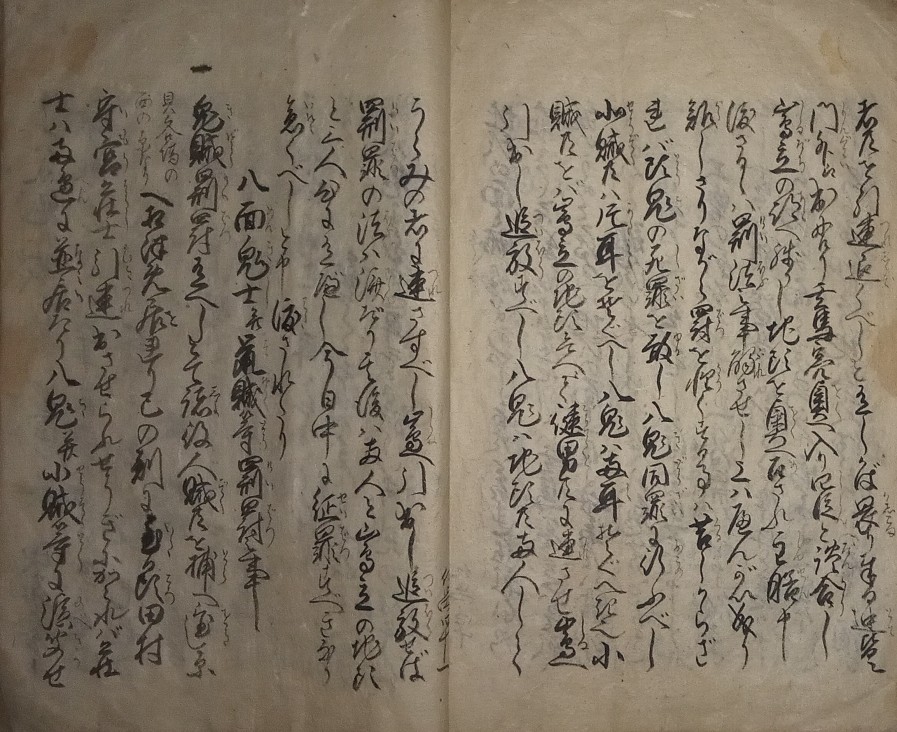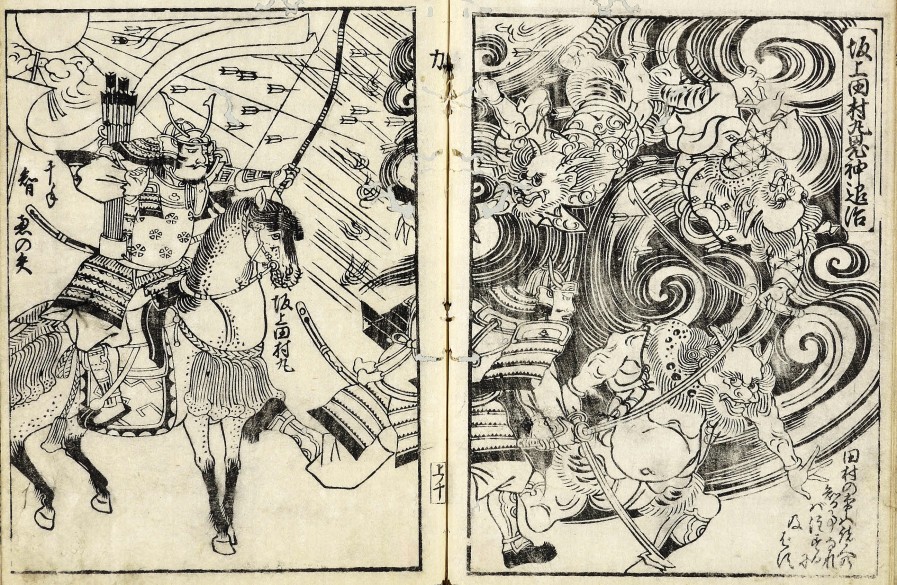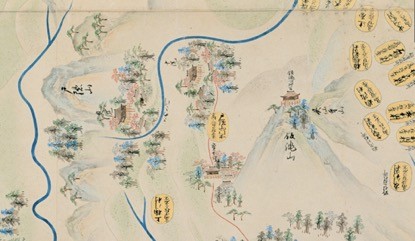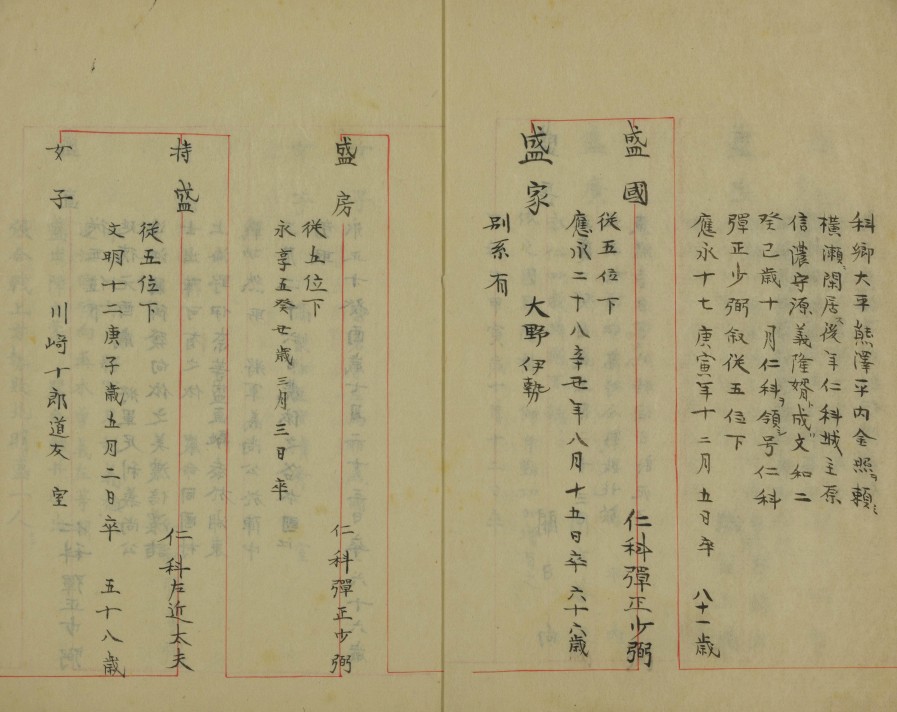
Perhaps the earliest origins of the Nishina (仁科家) family can be found in the Nishina Ranshoki document (仁科濫觴記) written at an undetermined date in the Edo period (江戸時代). The name Nishina originally came from King Nihon (仁品王) related to Emperor Sujin (崇神天皇) and in the 7th century, King Nihon's castle (仁品王城) name was changed to Nishina Castle (仁科城). Soon after, the Azumi area (安曇郡) would begin to have problems with certain thieves or robbers (鼠賊).

Image of the Nishina Ranshoki (仁科濫觴記) with the leader of the band of thieves (鼠賊) of the eight demons (八面鬼士).

Sculpture representing the ‘Great Eight-Faced King’ (八面大王)
This gang calling themselves the ‘Great Eight-Faced King’ (八面大王)*1 was led by the ‘great eight-faced demon warrior king’ (八面鬼士大王), said to be hiding in the cave Gishiki no Iwaya (魏石鬼窟)*2. Although some legend has it that Sakanoue Tamuramaro (坂上田村麻呂) defeated the band of thieves, this is believed to be incorrect and it was another member of the Tamura family, Tamura Morimiya (田村守宮) who was said to be related to the Nishina family.

Sakanoue Tamuramaro (坂上田浦麻呂) an expert in taking down demons.
En siglo 9 el asceta Gakumon Gyōja (学問行者) hizo el ritual de apertura de la montaña de Togakushi (戸隠山) donde se le apareció un dragón de nueve cabezas (九頭竜). Después el dragón de nueve cabezas se recluyó en una cueva en el montaña de Togakushi y Gakumon Gyōja lo hizo en una cueva de la montaña de Iizuna (飯綱山).
Desde ese momento en la montaña de Togakushi se adoraría a Kuzuryū (九頭竜) el dragón de nueve cabezas, un culto que llegaría a expandirse por todo Japón, llegando a forma parte del documento militar Heihō Hijutsu Ikkansho (兵法秘術一巻書). Haciendo de Togakushi e Izuna dos puntos de referencias para el shugendō (修験道) y las prácticas ascetas. Por su situación geográfica, el clan Nishina (仁科氏) fue quien más se pudo beneficiar de ambos cultos durante cientos de años. Pero, ¿fue un miembro del clan Nishina el fundador del Togakure Ryū?

Extract from the document Yoshitune Tora no Maki (義経虎巻) where the seal of Kuzuryū (九頭龍印) appears.
Later, during the Genpei Wars (源平合戦) of the late Heian period (平安時代), the powerful Nishina clan of the Azumi area were recruited into the army of Minamoto Kiso Yoshinaka (源木曽義仲) and fought several battles, with several members of the clan excelling in combat. According to tradition, until recently oral (口伝), the Togakure style of ninjutsu was founded by Togakure Daisuke (戸隠大助). One of the first lineages published*3 by Hatsumi Masaaki, the thirty-fourth exponent of the style (良昭初見三十三四代宗家), listed the following as the first generations:
Togakure Daisuke (戸隠大助) - Shima Kosanta Minamoto no Kanesada (志摩小三太源兼定) - Togakure Gorō (戸隠五郎) - Togakure Kosanta (戸隠小三太)....
This lineage matches that published in the 1978 Sengoku Ninpō Zukan (戦国忍法図鑑) but also adds the origins of the style*4 explaining that Shima Kosanta Minamoto no Kanesada was trained in Shugendō (修験道), Senban Nage jutsu (銛盤投術) and Hichō jutsu (飛鳥術). Wounded in the battle of Awazu () where Kiso Yoshinaka (木曽義仲) died, he was helped by Kain Dōshi (霞隠道士) an ascetic with whom he fled to the mountains of Iga and received his teachings in ninjutsu. This warrior adopted the name Togakure Daisuke and initiated the style of Togakure Ryū Ninjutsu (戸隠流忍術).
This statement at first glance may contradict the published lineages since according to the text, Togakure Daisuke and Shima Kosanta are the same person but according to the lineage, the founder was Togakure Daisuke and Shima Kosanta was the second exponent. But it can get even more complicated if we add another theory that Togakure Daisuke's ‘original’ name was Nishina Daisuke (仁科大助). According to the theory of Simizu Torazō (清水乕三)*5, a resident of the Togakushi area, Nishina Daisuke was a vassal of Kiso Yoshinaka who after being defeated at the battle of Awazu, he escaped to Iga and there added the ninjutsu of the Iga Ryū (伊賀流) to his knowledge of Togakushi and Izuna shugendo, Senban nage jutsu and Hicho jutsu. He changed his name to Togakure Daisuke and founded the Togakure style of ninjutsu.
Subsequently Shinji Sōya (宗谷真爾) reaffirms Nishina Daisuke as the founder of Togakure Ryū, Nishina Yukihiro as his father and that in addition to belonging to the family branch in the Azumi area, he seems to imply that Nishina Daisuke is documented in the manuscript ‘Shinshu Nishina no Maki’ (信州仁科巻) which he claims to have in his possession. Unfortunately, if such a document exists, it has not been released. Although by geographical location, if Nishina Daisuke did exist his origin could be linked to the Nishina clan of the Minochi area in Shinanō (信濃国水内郡仁科氏) being the area where the Togakushi and Iizuna mountains are located.
It is important to note that the fact that Togakure Daisuke is part of two lineages (Togakure Ryū and Iga Ryū) or even three lineages (it is said that Kain Doshi was an exponent of the Hakūn Ryū style (白雲流)), makes it difficult to pinpoint the exact name of the founder of a style that is native to the area.

Proximity between the Togakushi Mountains (戸隠山) to the left and Izuna (飯綱山) to the right
If the theory that Nishina Daisuke was the founder of the Togakure style is correct, finding that name within the complex web of family branches of the Nishina clan is complicated, perhaps because ‘Daisuke’ is most likely a nickname and not his real name.
If we look at two of the most important lineages of the Nishina clan, (first that of the Nishina clan members from the Azumi area (安曇郡仁科氏) who supported Kiso Yoshinaka, and secondly that of the Nishina clan members of the Minochi area (水内郡仁科氏) where the Togakushi (戸隠山) and Iizuna (飯綱山) mountains belong) we note that one of the most common surnames begins with the root ‘Mori’ (盛) in surnames such as Morihiro (盛弘), Moriie (盛家), Morimune (盛宗) and a long etcetera until the last great representative of the clan, Nishina Gorō Morinobu (仁科五郎盛信). Originally born as the fifth son of Takeda Shingen (武田信玄) he was adopted by the Nishina family with political interests. Perhaps also with political interests Shigen's son Takeda Katsuyori (武田勝頼) bestowed the name Nishina Jinjūrō (仁科甚十郎) on Nishina Morikiyo (仁科盛清) with the mission of managing the Iizuna shrine (飯綱神社).

Extract from the lineage of the Nishina clan of Minochi area (水内郡仁科氏)
The same happens when trying to relate Nishina Daisuke to Nishina Yukihiro (仁科幸弘) his supposed father. Such a statement can be found for the first time in the book ‘これが忍術だ’ by Koyama Ryūtarō (小山龍太郎) and later in two books by Hatsumi Masaaki, although pointing out that such a statement is not his*7. The only historical document where we can find ‘Nishina Yukihiro’ is the ‘Nihon Gaishi’ (日本外史). In successive publications, ‘footnotes’ were added to the original text, and copies would eventually be published under his full name, Nishina Tarō Yukihiro (仁科太郎幸弘). But this name may have been a mixture of Nishina Tarō Morihiro (仁科太郎盛弘)*8, a general under Yoshinaka who appears in the Genpei Seisuiki (源平盛衰記) and Unno Yukihiro (海野幸弘)*9 another high commander under Kiso Yoshinaka.

Nishina Tarō Yukihiro (仁科太郎幸弘) en dos versiones del Nihon Gaishi (日本外史)
Although there seems to be no record of Togakure Daisuke being Nishina Daisuke or Shima Kosanta Minamoto no Kanesada. It is true that it could be said that if there is no record it did not exist and perhaps it did or it could also be that the name is simply indicating that the origin of the style can be traced back to the Nishina family, Togakushi area or Shima area.
This also happens to ‘Izuna magic’ (飯綱の法)*10 created at the Izuna shrine. It is said that in the year 1233, Itō Heibu Daisuke Buzen no Kami Tadatsuna (伊藤兵部大輔兼豊前守忠綱) and his son Itō Jirōdayū Moritsuna (伊藤次郎大夫盛綱) made a deep study in the Izuna temple for a thousand days attaining immortality and founding the Izuna ninpō (飯綱忍法). Although father and son appear in the manuscript of the Edo period Izuna Yama Ryaku Engi (飯縄山略縁起), both members do not appear in the clan lineages (伊藤氏系譜). This is especially true of the origins of Ninjutsu styles.
August 25th, 2024, Ensanryū 鳶山龍
*1 - Also known as Gishiki Hachimen Daiō (魏石鬼八面大王).
*2 - Something like Fujiwara Chikata (藤原千方) hiding in a cave in his rebellion against the central government.
*3 - 武道日本, 森川, year 1966. The lineage published in the 1963 book Bugei Ryuha Jiten (武芸流派事典) does not correspond exclusively to that of the Togakure style, as the same diagram indicates that 21 generations are missing. It is a synthesis of various exponents of different Ninjutsu styles (Iga Ryū, Togakure Ryū, Gyokko Ryū, Kotō Ryū, Shinden Fudō Ryū).
*4 - 戦国忍法図鑑、初見良昭 1978. This information was expanded in the book ‘Way of the Ninja, Secret Techniques, author Hatsumi Masaaki, 2009.
*5 - 歴史読本、戸隠流忍法、初見良昭. Text previously published in the book いま忍者、見良昭, year 1981.
*6 - 半棒術・十手術・鉄扇術, author 初見良昭, year 1983 序文 (prologue)
*7 - いま忍者, author 初見良昭, year 1981; 半棒術・十手術・鉄扇術, author 初見良昭, year 1983
*8 - This note is further developed in Sean Askew's post:
*9 - Also written as 幸広, 幸廣
*10 - It is important not to limit Izuna no Hō to the use of enchanted foxes as this practice has been practised in Japan for centuries.



